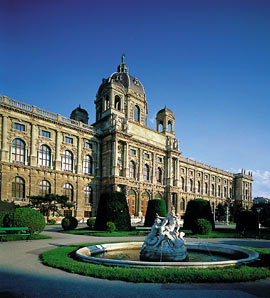 |
 |
 |
 |
 |
|
| Visit the Web site |
| Kunsthistorisches Museum, Vienna | ||
The Kunsthistorisches Museum traces its origins to the art collections assembled over centuries by the Habsburg dynasty. Holdings inherited from the Medieval rulers were augmented in the sixteenth century by emperors Maximilian I, Ferdinand I, Maximilian II, and, in particular, Rudolf II, who was the most prominent collector of the early Modern period. These monarchs enriched the imperial collections with objects of outstanding artistic importance. Archduke Karl of Styria, a great lover of the arts, and Archduke Ferdinand of Tyrol, who pursued varied interests, both followed in the footsteps of their imperial cousins. In the seventeenth century, Archduke Leopold Wilhelm, governor of the Spanish Netherlands, acquired a much celebrated collection of paintings. He bequeathed this collection to his nephew Emperor Leopold I, thus laying the cornerstone for the Kunsthistorisches Museum Picture Gallery. Subsequently every generation of the dynasty added to and enlarged the collections. The individual dynastic collections of the sixteenth century were kept in imperial residences in Vienna, Prague, Graz, and Ambras near Innsbruck. Through dynastic and political changes these collections were repeatedly moved and became increasingly concentrated in Vienna, the imperial capital and residence. Finally, toward the end of the nineteenth century Emperor Franz Joseph I succeeded in bringing all of the various collections together. The Kunsthistorisches Museum's palatial building was conceived together with the neighboring Museum of Natural History as part of the architectural master plan for the famed Ringstrasse. On October 17, 1891 the emperor inaugurated the magnificent new home for the imperial art collections. The diverse collections of paintings were combined to form the Kunsthistorisches Museum Picture Gallery, which comprises works from the fifteenth through the eighteenth centuries. Coins and medals from antiquity to the most recent times can be found in the Coin Cabinet. Ceremonial arms and armour from the fifteenth through the seventeenth centuries were amassed in the Collection of Arms and Armour. The development of modern conceptions of academic disciplines and research led to the "Universal Kunstkammer" splitting into the Collection of Greek and Roman Antiquities and the Egyptian and Near Eastern Collection, leaving the Kunstkammer with a core of works of decorative arts and sculpture. The Collection of Ancient Musical Instruments was assembled from the holdings of the Kunstkammer and the Este Collection. Following the demise of the Austro-Hungarian Empire in 1918, the Kunsthistorisches Museum's responsibilities extended to collections outside of the main building on the Ringstrasse. These included the Secular and Ecclesiastical Treasuries with the insignia of the Holy Roman Empire, the Austrian Empire, and ecclesiastic objects in the Hofburg palace, the collections of tapestries and court costumes, the Imperial Coach Collection in Schönbrunn palace, as well as the art collections in Schloss Ambras. In 1999, the Kunsthistorisches Museum, which had previously been subordinate to the Federal Ministry for Education, Science, and Culture, was vested with fully autonomous legal status. This permits independent decisions concerning the museum's finances. The museum's responsibilities include the preservation, enlargement, study, display, and administration of its collections. As of January 1, 2001 the Ethnological Museum and Austrian Theater Museum were incorporated into the Kunsthistorisches Museum. The unsurpassed quality of the museum's holdings and its extensive program of major exhibitions make it one of the chief cultural attractions for visitors to Austria from all over the world. |